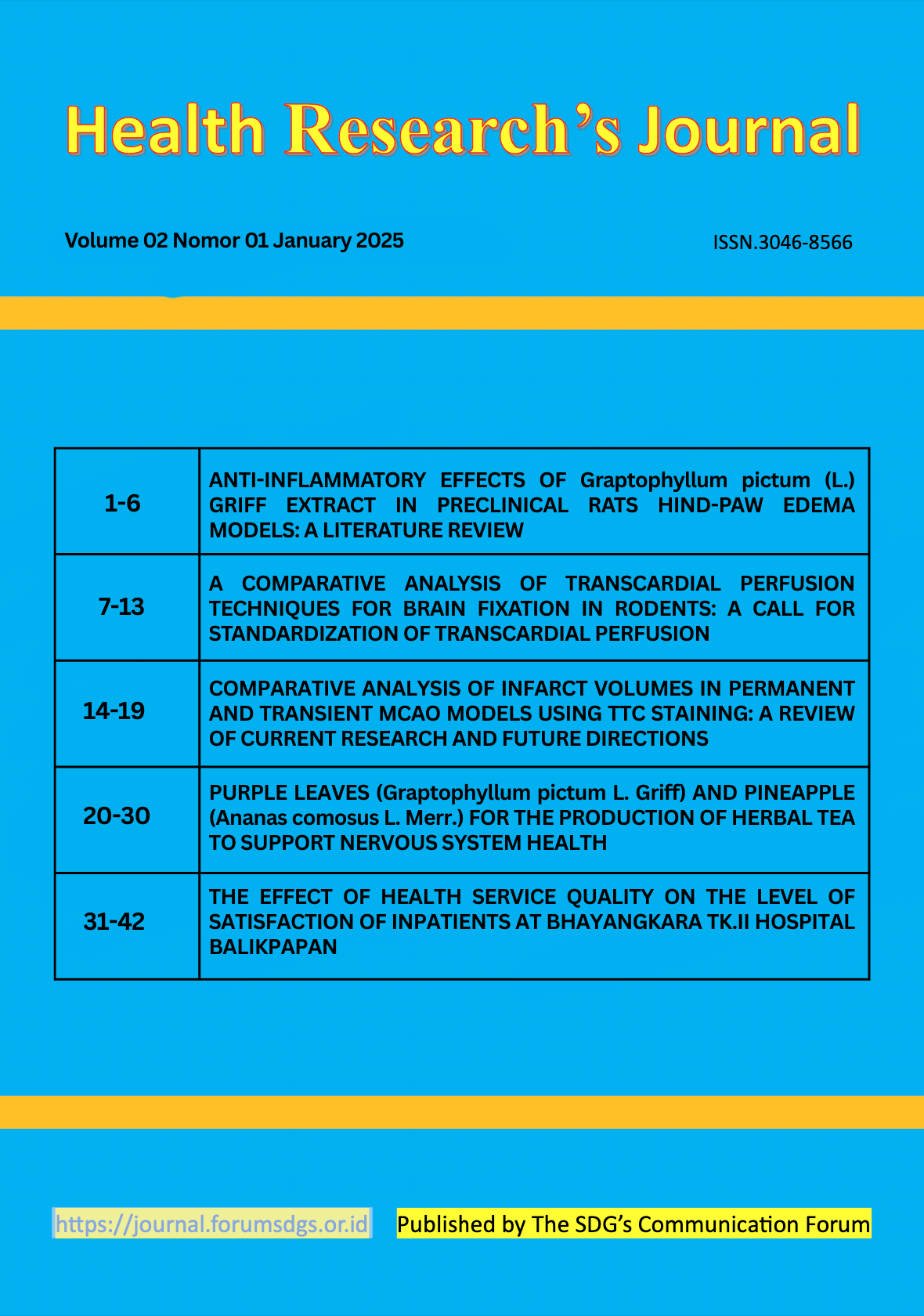A COMPARATIVE ANALYSIS OF TRANSCARDIAL PERFUSION TECHNIQUES FOR BRAIN FIXATION IN RODENTS: A CALL FOR STANDARDIZATION OF TRANSCARDIAL PERFUSION
DOI:
https://doi.org/10.00000/6nrjth51Keywords:
Trancardial perfusion, Brain perfusion, Animal model, Paraformaldehyde, Tissue preservationAbstract
Transcardial perfusion is a crucial technique in rodent research for tissue fixation and preservation. The process typically involves flushing the vascular system with saline to remove blood, followed by fixation with 4% paraformaldehyde (PFA) or formalin. However, differences in species, procedural techniques, and fluid volumes can influence perfusion efficiency and tissue quality. This literature review compares six transcardial perfusion protocols used in mice and rats, focusing on procedural variations and fluid volume requirements. Data were collected from published protocols detailing perfusion techniques, obtaining evidence that substantial variability is observed in the protocols, including differences in anesthesia regimens, surgical approaches, perfusion techniques, fluid compositions, and fixation outcomes. Future research should focus on standardizing perfusion protocols to improve consistency in fixation quality, minimize tissue degradation, and preserve structural and molecular integrity.
References
Abed, M. (2023) ‘A Comprehensive Examination of Human Brain Disorders’. Bauer, D.R., Otter, M. and Chafin, D.R. (2018) ‘A New Paradigm for Tissue Diagnostics: Tools and Techniques to Standardize Tissue Collection, Transport, and Fixation’, Current Pathobiology Reports, 6(2), pp. 135–143. Available at: https://doi.org/10.1007/s40139-018-0170-1.
Campbell, B.C.V. et al. (2019) ‘Ischaemic stroke’, Nature Reviews Disease Primers, 5(1), p. 70. Available at: https://doi.org/10.1038/s41572-019-0118-8.
Cervellati, C. et al. (no date) ‘Inflammation in neurological disorders: the thin boundary between brain and periphery’, Antioxidants and Redox Signaling [Preprint].
Domínguez-Oliva, A. et al. (2023) ‘The Importance of Animal Models in Biomedical Research: Current Insights and Applications’, Animals, 13(7), p. 1223. Available at: https://doi.org/10.3390/ani13071223.
Gage, G.J., Kipke, D.R. and Shain, W. (2012) ‘Whole Animal Perfusion Fixation for Rodents’, Journal of Visualized Experiments, (65), p. 3564. Available at: https://doi.org/10.3791/3564-v.
Kasukurthi, R. et al. (2009) ‘Transcardial perfusion versus immersion fixation for assessment of peripheral nerve regeneration’, Journal of Neuroscience Methods, 184(2), pp. 303–309. Available at: https://doi.org/10.1016/j.jneumeth.2009.08.019.
Kim, C.K. et al. (2022) ‘Alzheimer’s Disease: Key Insights from Two Decades of Clinical Trial Failures’, Journal of Alzheimer’s Disease, 87(1), pp. 83–100. Available at: https://doi.org/10.3233/JAD-215699.
Matsubara, N.K. and Da Silva-Santos, J.E. (2024) ‘The Dual Cardiovascular Effect of Centrally Administered Clonidine: A Comparative Study between Pentobarbital- and Ketamine/Xylazine-Anesthetized Rats’, Future Pharmacology, 4(1), pp. 17–29. Available at: https://doi.org/10.3390/futurepharmacol4010003.
McFadden, W.C. et al. (2019) ‘Perfusion fixation in brain banking: a systematic review’, Acta Neuropathologica Communications, 7(1), p. 146. Available at: https://doi.org/10.1186/s40478-019-0799-y.
Mohamed, A.S. et al. (2020) ‘Sodium pentobarbital dosages for exsanguination affect biochemical, molecular and histological measurements in rats’, Scientific Reports, 10(1), p. 378. Available at: https://doi.org/10.1038/s41598-019-57252-7.
Navarro, K.L. et al. (2021) ‘Mouse Anesthesia: The Art and Science’, ILAR Journal, 62(1–2), pp. 238–273. Available at: https://doi.org/10.1093/ilar/ilab016.
Pérez Arévalo, A. et al. (2022) ‘Trans-cardiac perfusion of neonatal mice and immunofluorescence of the whole body as a method to study nervous system development’, PLOS ONE. Edited by A. Kavushansky, 17(10), p. e0275780. Available at: https://doi.org/10.1371/journal.pone.0275780.
Rain Kwan et al. (2022) ‘Transcardial perfusion of mouse tissues v1’. Available at: https://doi.org/10.17504/protocols.io.rm7vzywnxlx1/v1.
Rana, A., Massa, P.T. and Chen, X.J. (2022) ‘A Gravity-Fed Transcardial Perfusion Method for Histologic Analysis of the Mouse Central Nervous System’, Journal of Visualized Experiments, (179), p. 63386. Available at: https://doi.org/10.3791/63386.
Ruggeri, B.A., Camp, F. and Miknyoczki, S. (2014) ‘Animal models of disease: Pre-clinical animal models of cancer and their applications and utility in drug discovery’, Biochemical Pharmacology, 87(1), pp. 150–161. Available at: https://doi.org/10.1016/j.bcp.2013.06.020.
Trotman-Lucas, M. and Gibson, C.L. (2021) ‘A review of experimental models of focal cerebral ischemia focusing on the middle cerebral artery occlusion model [version 2; peer review: 2 approved]’.
Wu, Jinyun et. al. (2021) ‘Transcardiac Perfusion of the Mouse for Brain Tissue Dissection and Fixation’, Bio-Protocol, 11(5). Available at: 10.21769/BioProtoc.3988
Zatroch, K.K. et al. (2016) ‘Refinement of intraperitoneal injection of sodium pentobarbital for euthanasia in laboratory rats (Rattus norvegicus)’, BMC Veterinary Research, 13(1), p. 60. Available at: https://doi.org/10.1186/s12917-017-0982-y. Zehravi, M. et al. (2022) ‘A Prospective Viewpoint on Neurological Diseases and Their Biomarkers’.


